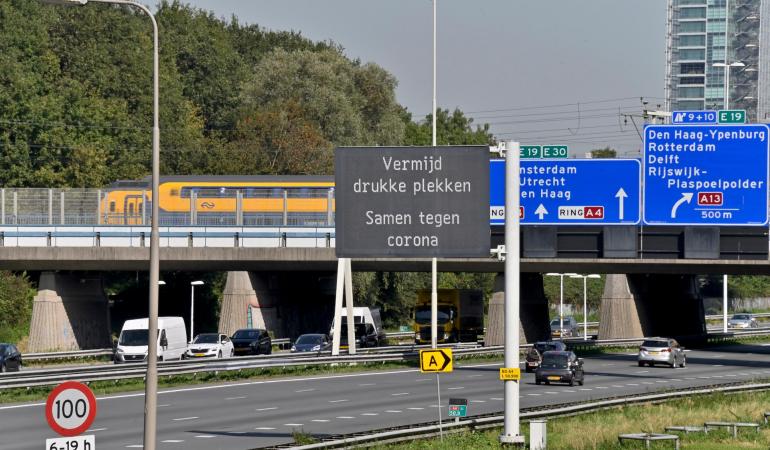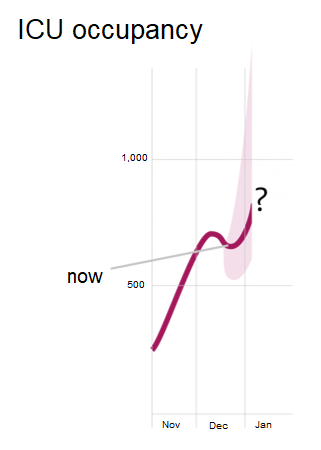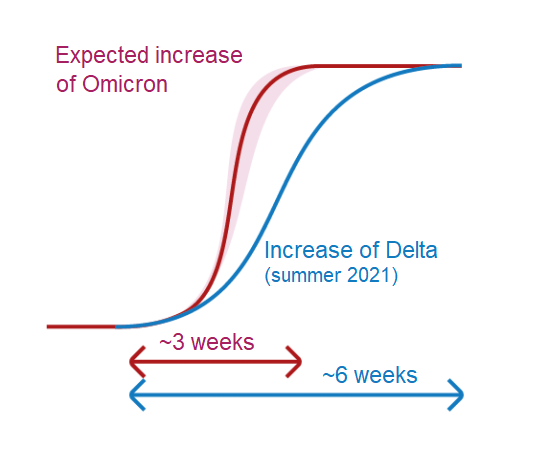
Infections involving the Omicron variant are still in the minority for now, but are increasing rapidly. The new variant is spreading so fast that Omicron will probably be the most common variant of the coronavirus SARS-CoV-2 in the Netherlands before the end of the year. This rapid spread may lead to a high peak in hospital and ICU admissions – a peak that could significantly exceed care capacity. To prevent this, the Outbreak Management Team (OMT) has recommended expanding the evening lockdown within the very near future.
The increasing incidence of the Omicron variant in the Netherlands is happening as the effect of the government measures at the end of November is becoming apparent. ICU and hospital admissions are now dropping, as are new infections (Figure 1). However, the scientific models show that this decrease will be brief. This is because the Omicron variant can spread very quickly, even among people who are vaccinated (Figure 2).
Figure 1: The number of beds occupied in the intensive care units (ICU) is currently decreasing. Projections show that this number is expected to rise rapidly in the new few weeks.
Figure 2: The Omicron variant is spreading in the Netherlands about twice as fast as the Delta variant last summer.
Scenarios
RIVM modellers calculated different scenarios to see how fast the virus could spread under different conditions. Despite the many uncertainties, it seems clear that the current measures alone are insufficient to maintain a manageable burden of care in hospitals and nursing homes. Additional measures can reduce the number of new infections and thus relieve the pressure on the healthcare system. Measures also provide extra time to vaccinate as many people as possible during the booster campaign. For example, implementing a strict lockdown can help significantly reduce the number of ICU admissions in the Netherlands.
Uncertainties
The Omicron variant has only just been discovered, so there is still much to learn. It is not yet clear how many admissions could be caused by the variant, how well people are protected as a result of previous infection or vaccinations, or how high vaccination coverage will be for the booster vaccination. As a result, it is also possible that the pressure on the healthcare system will be lower, for example, if Omicron turns out to be less virulent. The OMT emphasises that various essential properties of the Omicron variant, such as its potential to cause illness (virulence), are not yet clear. However, the risk is currently too high to wait any longer to implement measures, since the variant is spreading very rapidly. If it becomes apparent that Omicron infections are much milder, then the OMT will quickly recommend relaxing the lockdown again.
Booster vaccination
The height of the peak, the number of people who become ill, and the number of hospital admissions can be reduced by giving the booster vaccination to as many vaccinated people as possible, as soon as possible. It will also help to increase vaccination coverage among people who are not yet vaccinated. To give the booster campaign a chance to reach as many people as possible in time, it is important to implement extra measures now. Measures in addition to the evening lockdown will slow down the rising incidence of the Omicron variant. Slowing the spread can contribute to maximising the number of people who are vaccinated in time.

